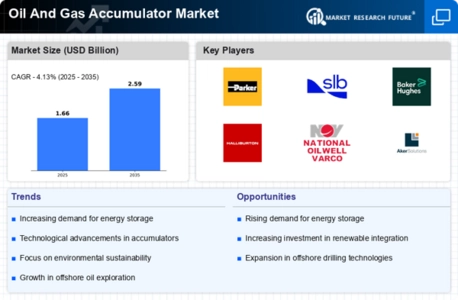Regulatory Compliance and Safety Standards
Regulatory compliance and safety standards are increasingly influencing the Oil And Gas Accumulator Market. Governments and regulatory bodies are implementing stringent safety regulations to mitigate risks associated with oil and gas operations. These regulations often necessitate the use of advanced accumulator systems that can withstand high pressures and ensure safe operation. The market is witnessing a shift towards accumulators that not only meet these safety standards but also enhance operational efficiency. As companies strive to comply with these regulations, investments in high-quality accumulator systems are expected to rise. This trend is likely to drive innovation within the Oil And Gas Accumulator Market, as manufacturers develop products that align with evolving safety requirements while also improving performance and reliability.
Rising Demand for Energy Storage Solutions
The increasing demand for energy storage solutions is a pivotal driver for the Oil And Gas Accumulator Market. As energy consumption continues to rise, the need for efficient storage systems becomes paramount. Accumulators play a crucial role in stabilizing energy supply, particularly in oil and gas operations where fluctuations in demand can occur. The market for energy storage is projected to grow significantly, with estimates suggesting a compound annual growth rate of over 20 percent in the coming years. This growth is likely to be fueled by the need for reliable energy sources and the integration of renewable energy systems, which often require robust storage solutions to manage intermittent supply. Consequently, the Oil And Gas Accumulator Market is positioned to benefit from this trend, as companies seek to enhance their operational efficiency and energy reliability.
Increased Investment in Oil and Gas Exploration
Increased investment in oil and gas exploration is a critical driver for the Oil And Gas Accumulator Market. As energy companies seek to tap into new reserves, the demand for reliable and efficient equipment, including accumulators, is on the rise. Exploration activities often involve complex operations that require robust energy management systems to ensure operational efficiency. Market analysis suggests that exploration budgets are expected to increase, particularly in regions with untapped resources. This trend is likely to lead to a surge in demand for accumulators that can support these operations, thereby enhancing the overall performance of oil and gas projects. Consequently, the Oil And Gas Accumulator Market stands to benefit from this influx of investment, as companies prioritize the acquisition of advanced accumulator systems.
Technological Innovations in Accumulator Design
Technological innovations in accumulator design are significantly shaping the Oil And Gas Accumulator Market. Advances in materials science and engineering have led to the development of more efficient and durable accumulator systems. These innovations include the use of composite materials that reduce weight while enhancing strength and pressure resistance. Furthermore, the integration of smart technologies allows for real-time monitoring and predictive maintenance, which can optimize performance and reduce downtime. As the industry increasingly adopts these advanced technologies, the demand for modern accumulator systems is expected to rise. Market data indicates that companies investing in innovative accumulator designs are likely to achieve competitive advantages, thereby propelling growth within the Oil And Gas Accumulator Market.
Focus on Operational Efficiency and Cost Reduction
The focus on operational efficiency and cost reduction is driving growth in the Oil And Gas Accumulator Market. Companies are increasingly seeking ways to optimize their operations and minimize costs, particularly in a competitive market environment. Accumulators play a vital role in enhancing operational efficiency by providing reliable energy storage and management solutions. By investing in high-performance accumulator systems, companies can reduce energy waste and improve overall productivity. Market trends indicate that organizations prioritizing efficiency are more likely to adopt advanced accumulator technologies that offer better performance and lower operational costs. This emphasis on cost-effective solutions is expected to propel the Oil And Gas Accumulator Market forward, as businesses strive to maintain profitability while meeting the demands of a dynamic energy landscape.



.webp)
.webp)
.webp)
.webp)
.webp)
.webp)








Leave a Comment